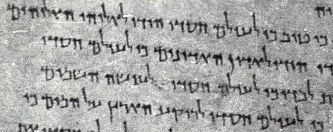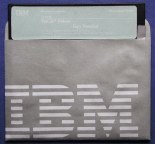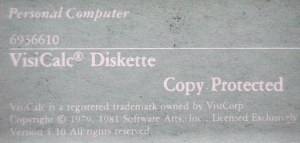Dan Bricklin's Web Site: www.bricklin.com
|
|
Copy Protection Robs The Future
Copy protection will break the chain of formal and informal archivists who are necessary to the long-term preservation of creative works.
|
|
Introduction
The other day I wanted to listen to a song I remember from my youth. I took the old vinyl record out of its sleeve and put it on my aging turntable. I gently dropped the needle onto the appropriate track, and out came the music, but it was way too fast. It seems my turntable broke, and now plays everything at exactly 45 rpm instead of 33. Bummer! It was a slow song and I wanted it slow. Luckily, I found I had another copy of the same song that the record company that owned the rights to the song had released (the CD was "Greatest Folksingers of the 'Sixties"). Much nicer. Unfortunately, they had only included that one song -- I couldn't play any of the others I wanted from the original album. I'll have to try to fix my turntable.
This got me to thinking about preserving old works of composers, musicians, authors, and other creative individuals. How does that preserving come about and will today's works produced on digital media last into the future?
How are works preserved through the generations?
As human beings, we benefit greatly from the works of others. Artists, thinkers, scholars, and performers create works that we all enjoy, learn from, and are inspired by. Many works are timeless. Either standing alone or in the context of their time or other times, they are valuable periodically years after they are created. We often hear of authors, artists, or composers who only become popular or have their greatest impact after their death, sometimes many years later.
How are these works passed down through the generations? It usually isn't the direct result of the efforts of the original creator. Other people make it their job to preserve the works and pass them on. These jobs are either formal, like librarians and curators, or informal, like enthusiasts and hobbyists. There are additional other people who find interesting works and bring them to the attention of new generations. These may be scholars doing research, or a collector who develops a strong passion.
How are the actual works preserved? Sometimes just storing the work is sufficient, but in most cases a change in environment is needed. The artist's original location may be sold for another use. The work may be created in a material that is affected by air and water, and must be kept in a temperature- and humidity-controlled room. To preserve unique items, we often need to go to extremes, even to preserve them for just a few hundred years. According to a professional preserver, the Archivist of the United States, the US Constitution, Bill of Rights, and Declaration of Independence are stored in an encasement "...made of pure titanium, high-strength glass, and specially treated aluminum to encapsulate these aging, fragile documents in argon, an inert gas, for their long-term preservation..."
For some works, it's enough to just preserve the words themselves. For these and others, copies are what we preserve, such as recordings of performances, or microfilm copies of newspapers. We produce the copies in more stable media, or ones that are easier from which to reproduce. (In a way, this is a form of "changing the environment".) The practice of constantly producing new copies before the old copies wear out has worked well. To increase the likelihood of long-term survival for a work, such as a religious text, producing many copies and keeping them in diverse places has also worked very well.
With ever changing technology, in order to preserve many works we will need to constantly move them ahead, copying them to each new media form before the previous one becomes obsolete. Also, as we create new media, we need to preserve the knowledge of the methods of converting from one media to another, so we can still access the old works that have not yet been moved ahead. This is crucial. Without this information, even preserved works could be unreadable.
The most famous example of that type of translation information was an inscribed slab of rock from 196 BC found in 1799. It contained a decree written in Greek that was also written in two forms of Egyptian. It's called the Rosetta Stone. It let scholars finally read ancient works in hieroglyphics that they had physical possession of but whose language had been a mystery for 1,400 years (despite being common for the 3,500 years before being superseded). Cuneiform, a form of writing used by many ancient civilizations, was similarly opaque to scholars until they found a text in multiple languages carved into a cliff -- the Behistun inscription.
 Cuneiform writing that I photographed in 1966 at a NYC museum
A well known example of preserving a work for many years is the Dead Sea Scrolls. These 2000-year old scrolls contain copies of Biblical and other writings. Thanks to the unusual environmental conditions of where they were stored (Qumran), they survived relatively intact. They were mainly written in the same Hebrew letters used today. I was fortunate to visit some of these at an exhibit in the United States in the mid-1960's. I took pictures of some of those that I saw at the request of one of my teachers for his research. I found those old negatives a few days ago, and, though you can't read such tiny negatives with your naked eye, my made-in-2001 film scanner can read them 35 years later. Looking at those images, I can read them now (I know modern Hebrew) and found that I photographed what looks like a variant of Psalm 136:
 Dead Sea Scroll, still readable 35 and 2000 years later. It starts: "...Key Tove, Key L'Olam Chasdoh -- ...for He is good, for His mercy endures forever."
This is an example of many types of preserving: Repeated copying of the Psalms for hundreds of years from their original authoring until the days of the people at Qumran, good preservation of their copy for 2000 years, independent preservation of the language, sharing of the work by the current preservers with the help of institutions like museums, having a copy made yet again for an enthusiast (by me for my teacher), preserving those copies (me and my parents who saved them at home for many years with my other negatives), today's film scanners being able to read the old film which was created before the idea of digital scanning, and finally, me being able to read it and then share yet another copy with you through the Internet. If you show it to someone who knows Hebrew, they should be able to read most of it. Quite a long, unbroken path. Let's hope we can continue to preserve things so well through so many steps.
Enter copy protection
There are things happening that make me worry that the future may not be bright for preserving many of the works we create today. For example: Companies are preparing to produce music CDs that cannot be copied into many other formats (something allowed by law as "fair use"). Most new eBooks are copy protected. A new bill may be heading to Congress that will require all digital devices to enforce copy protection schemes for copyrightable material. An existing law makes it a crime to tell people how to make copies of protected works.
I believe that copy protection will break the chain necessary to preserve creative works. It will make them readable for a limited period of time and not be able to be moved ahead as media deteriorates or technologies change. Only those works that are thought to be profitable at any given time will be preserved by their "owners" (if they are still in business). We know from history that what's popular at any given time is no certain indication of what will be valuable in the future. Without not-copy protected "originals", archivists, collectors, and preservers will be unable to maintain them the way they would if they weren't protected. (Many of these preservers ignore fashion as they do their job, because they see their role as preservers not filters.) We won't even be able to read media in obsolete formats, because the specifications of those formats will not be available. To create a "Rosetta Stone" of today's new formats will be asking to go to jail and having your work banned.
This is different than encryption or patent protection. With encryption, as long as the keys for reading survive, and a description of the method of decryption, you can recreate the unprotected original. It's even better -- you can prove authenticity. Patent protection just keeps you from creating and using your own unlicensed reader for a limited period of time. After that, the legal duty of the patent is to teach you how it works so you can make your own. For long-term preservation of works (as opposed to short-term quick advancement in some fields) patented techniques are good because they discourage secrets and eventually put things in the public domain.
Let me give you another personal example, this time about copy protection.
One of the most popular parts of this web site is a copy of the original IBM PC version of VisiCalc. Actually, that's not exactly true. It's not the same exact program you could buy. The original VisiCalc was only shipped on 5 1/4" copy protected diskettes. Part of the program checked that the diskette it was loaded from had the special copy protection modifications. Despite the fact that I have an old computer with a 5 1/4" diskette drive, I still couldn't make a copy that would run that I could distribute. I received permission from the current copyright holder to distribute the copies, but VisiCalc hadn't been produced for years and they lost track of any original masters they had owned. (Companies usually don't have reason to maintain and catalog old, non-profitable material for too long, especially through mergers and acquisitions.) Luckily for me, an employee of Software Arts, my company that created the original program, kept a "test" copy we had used internally that was created without the copy protection code. He was not one of the original authors, but is an informal "collector" of things. He ended up at Lotus, the next owners of the rights. He left Lotus years later, and gave me a copy he had moved ahead from system to system after that (he produced the copy for me on a Windows NT machine). Thanks to Lotus' permission (which I wouldn't need in the far future when the copyright expires), I was able to post a copy on the Web, and now many tens of thousands of people have their own copies. Thanks to those not-copy protected copies, and the documentation available about the original IBM PC, it is much more likely now that future generations will be able to learn about early PC programs by running VisiCalc. If only the original diskettes could be passed down, then after they deteriorated they would not be useable, and until then, only people with special obsolete equipment could run them.
  The IBM PC VisiCalc diskette with "Copy Protected" warning
Conclusion
Copy protection, like poor environment and chemical instability before it for books and works of art, looks to be a major impediment to preserving our cultural heritage. Works that are copy protected are less likely to survive into the future. The formal and informal world of archivists and preservers will be unable to do their job of moving what they keep from one media to another newer one, nor will they be able to ensure survival and appreciation through wide dissemination, even when it is legal to do so.
If you are an artist or author who cares more than about the near-term value of your work, you should be worried and be careful about releasing your work only in copy protected form. Like the days when "art" was only accessible to the rich, two classes will probably develop: Copy protected and not copy protected, the "high art" and "folk art" of tomorrow.
Artists and authors need to create their works and still make a living. Copy protection is arising as a "simple fix" to preserve business models based upon the physical properties of old media and distribution. Our new media and distribution techniques need new business models (perhaps with different intermediate players) that don't shortchange the future. Trying to keep those old business models in place is as inappropriate as continuing to produce only 33 rpm vinyl records.
|
|
|
© Copyright 1999-2018 by Daniel Bricklin
All Rights Reserved.
|